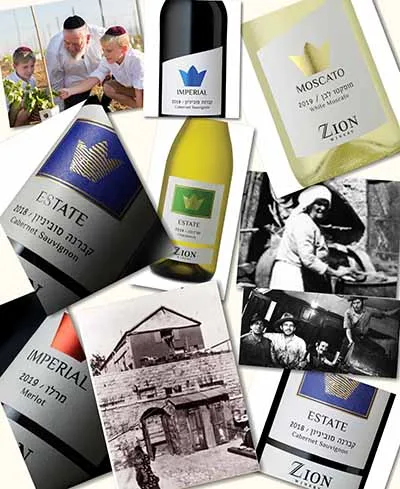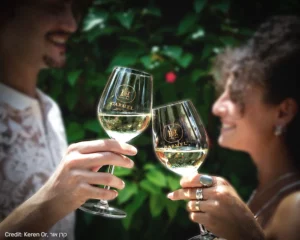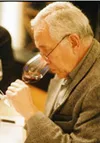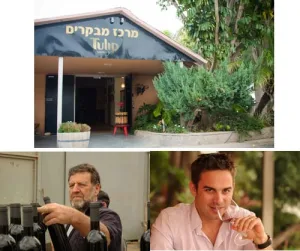Zion is a winery that has been around longer than any. It has been known as Zion Winery from the 1940’s onwards, but previously to that was known at different times as the Shor family winery, Shor Bros or AM Shor Winery. It was founded in 1848 and remains the oldest of any existing winery. During all this time it has been owned by the Shor family, managed by the Shor family and uniquely, even the winemaker has always been from the Shor family. There is no winery in Israel that can compete with this richness of heritage, longevity and continuity. It was around long before names like Carmel, Baron Edmond de Rothschild, Rishon Le Zion and Zichron Ya’acov came to dominate the Israel wine scene. Why this is interesting is that most experts think Israeli wine began in the 1880’s, but in fact winemaking continued throughout the previous years, even if it was low key. Jews and Palestinian Christians always made wine, but it was more domestic and local, certainly not a commercial industry.
The Zion Winery has always been under the radar, supplying its own market sector, modestly, without bells and fireworks. Yet, it has quietly grown to become the 6th largest winery in Israel, producing 3.5-4 million bottles a year! Now, it is being relaunched with a new logo, new labels and a new attention to quality at every price point.
Theirs is a family journey lasting 170 years, which began in the Muslim Quarter of the Old City of Jerusalem, travelled via Beit Israel in Western Jerusalem and ended up in Mishor Adumim in the Judean Desert, but not so far from Jerusalem. The winery was born under the auspices of the Ottoman Empire, continued under the British Mandate and finally, flourished in the State of Israel. It is an extraordinary story, and its beginnings coincided with the visits to Israel of a member of my family, Sir Moses Montefiore. This makes their story doubly interesting for me personally.
It began when Rabbi Mordechai Avraham Galin (aka Galina), arrived from the Ukraine in 1835 and settled in Safed. The family moved to the Old City of Jerusalem when he became head of the Yeshiva ‘Tiferet Yisrael.’ Englishman, Moses Montefiore was the most prominent visitor to Palestine in the 19th century. He saw first-hand the poverty and overcrowding of residents there. In 1839, he suggested Jews should earn a living instead of barely surviving off charity and he became the first to recommend that they should return to agriculture.
Yitzhak Galina-Shor, Rabbi Mordechai’s son, took into account the experiences of his father and the vision of Montefiore. He understood the family needed to earn a livelihood and saw potential in producing wines. It is fortunately a fact that observant Jews have always required wine for religious ritual. His sister had married a Baruch Shor, who by chance happened to have a rare license given by the Ottoman Turks for trading in alcohol. So, they changed their name to Shor, used Baruch Shor’s license and opened a winery in 1848 in the Old City of Jerusalem. The first harvest of the new winery coincided with Montefiore’s third visit to the Holy Land. It was a domestic winery, in the heart of the Muslim quarter, adjacent to the Kotel Hakatan (Little Western Wall). They put barrels as a barrier alongside the holy wall, so no-one would inadvertently touch the forbidden Temple Mount. Ironically, the first evidence of the family’s involvement in the wine trade was contained in the census commissioned by Moses Montefiore in 1849.
Then it was a very different world. In those days there was no bottled wine, no labels, no brands and no kashrut certificate. Wine was sold in small casks. It was categorized as sweet or sour, but over 95% was sweet. The Shor family winery also produced arak, brandy and vodka.
All Shor Winery’s grapes came from Hebron vineyards owned by Arabs. Payment was made in advance to reserve the crop. Local grapes like Bittuni, Dabouki and Zeini, now being revived, were amongst the varieties used. Grapes were delivered to the winery on a drove of donkeys travelling from Hebron.
Moses Montefiore, a forerunner of Zionism, was a wine lover, who drank a bottle of wine every day. He visited the Holy Land on seven occasions. At every meeting, he was presented with wine as a token of respect by the local community. Then wines did not have brand names, but the description ‘Hebron wine’ comes up in his diaries many times. Montefiore himself was one of those who bought small casks of wine as souvenirs. It is true that wine is not at the forefront of any history of Montefiore, but all the evidence is there in his diaries. According to the Shor family folklore, Moses Montefiore did meet Rabbi Mordechai Avraham, in his capacity as Rosh Yeshiva. Who knows, maybe one of the wines from Hebron he drank or the cask he purchased, was from the Shor family winery. It was certainly quite possible to have been the case.
As the Shor Winery became established, Moses Montefiore continued his commitment to agriculture and Jerusalem. In 1855 he became the first person to buy land for Jewish agriculture, purchasing an orchard in what was then considered Jaffa, but today it equates to the Montefiore Quarter of Tel Aviv. He also bought the land which became the first neighborhood outside the Old City of Jerusalem to alleviate overcrowding. It was stony and was covered with wild vines and olive trees, so he named it ‘Kerem Moshe’ (Moses’ Vineyard.) This area was later renamed Mishkenot Sha’ananin and Yemin Moshe, and it became the cornerstone of modern & western Jerusalem. He also built the iconic windmill in 1857, which is today known as the Montefiore Windmill. It was in accordance with his original vision: work and study. As written in Ethics of the Fathers: “If there is no flour, there is no Torah; if there is no Torah, there is no flour.” He instructed residents to plant vines and olive trees to get a taste of agriculture. However, planting of Jewish vineyards on a national scale did not really begin until the 1880’s, and then it was with the sponsorship and expertise provided by Baron Edmond de Rothschild.
In the meantime, the wine trade proved to be a success and the Shor family winery became the foremost wine producer in the Old City. When Yitzhak passed away, the baton was passed onto his son, Shmuel Shor, and his legendary wife, Rosa. She was a formidable woman. She opened a wine store called Khamra Rosa in the Cotton Market. It was not the first shop selling wine and spirits, but it was the first shop to operate like a wine bar and because of her character, it was by far the most famous! Her memory lives on. Arab elders still give respect today to a visiting member of the family, as soon as they hear they are related to Rosa.
In 1925 the Shor Winery had to leave the Old City on the request of the British Mandate. They moved to Beit Israel. In the new winery, the living quarters were on the top floor, the winery on the ground floor and the cellar, previously a water well, was in the basement. When Shmuel Shor passed away, Rosa took over, becoming the first ever female manager of a winery in Israel.
Glass became cheaper and wine gradually came to be sold in bottles. Bottling was done manually. Alicante became the main variety. Early labels were strictly informative with basic typed information on a white background. Then when they began to be used for marketing purposes, labels became more colorful.
In 1944, the company name was changed to Zion Winery. As the family had grown, the two brothers who were partners, decided to split the business. There was an agreement. Avraham Meir Shor’s Zion Winery continued to focus on wine and grape juice, whilst Moshe Shalom Shor’s new Shimshon Winery concentrated on spirits and liqueurs. Moshe Shalom Shor passed his Shimshon Winery onto his son in law and daughter. It was later sold and is today known as Jerusalem Wineries. His other children founded new Shor owned wineries, which in time came to be known as Arza and Hacormim wineries. However, Zion Winery was the one that had continuously made wine since 1848.
Two things surprised me about this Haredi, Ashkenazi family. Firstly, the family spoke Arabic, which was logical and practical, so they could communicate with their neighbors and suppliers. Secondly the family served in the IDF. Unfortunately, in the War of Independence, they had to recover from devastating blows.
In 1982, the Zion Winery moved to Mishor Adumim. In 1989, I became the first member of my family to make Aliyah, along with my wife and three children. In the five generations since Moses Montefiore no one else had taken the plunge. I began to work in the Israeli wine trade and was eager to learn everything I could. I was intensely curious about what was referred to as ‘the Jerusalem wineries,’ who no-one knew anything about. These included Zion, Arza, Hacormim and Shimshon. So I decided to visit them out of the blue in the early 1990’s. There was a certain surprise to see me, because outside visitors were rare. I saw wineries which were in a kind of time warp. It was simply how they were then. They were insular, inward looking, and devoted to providing cheap wines and liquid religion to the religious community.
What has happened since then at Zion Winery is astonishing and I have been able to monitor every stage, firstly as a competitor (with the Golan Heights and Carmel wineries), then as a wine writer and finally as a consultant. I have visited them over three decades and got to know three generations of the family, whom I spent time with in turn, in order to learn the inside story. The truth is that they have built a very serious, well-equipped state-of-the-art winery, which is spotlessly clean. The winery grew and expanded, but really took off in the 2000’s. There were three family members who created what is nothing short of a revolution. The late Moshe Shor, the CEO, was the driver. He was a bulldozer and had a fascination with machinery and equipment. He began a process of investing in the winery. When I was at the winery, he was never in the CEO’s chair, but usually in the winery checking out that things were working. When I visited not so long ago, there were incongruously a number of Chinese people in the winery. “Who are they?”, I asked. “Oh”, I was told “they are installing a robot for the bottling line!”
Then there was his nephew, Zvika Shor, who took over from his father as winemaker in 1992. Zvika Shor is bright, friendly, with a Herzlian beard and striking blue eyes. He has absorbed the proud heritage of the Shor family and lately has been at the center of a whirlwind of changes. It all began one harvest in 1995 when a grower rang him up and said “I have some spare Cabernet Sauvignon. Can you use it?” By that time Carignan was the main variety used, but Zvika thought no harm in trying, so he said yes and fermented the wine in a small fiberglass tank in the corner of the winery. When he leant over and put his nose in the container, the power and depth of the aromas was so much greater than anything he had had before. He was hooked. It was an epiphany moment. For the first time they purchased better quality grapes and brought their first small oak barrels from Teperberg. After a lifetime in wine, with no ego and being unafraid to ask questions, Zvika Shor, who was virtually born in a bottle, started his education again.
The third key to success was Yossi Shor, son of Moshe. He was the dynamic, creative marketing manager, with a modern outlook. What Moshe managed to do within the winery and Zvika achieved with the wine, Yossi succeeded to do outside the gates of the winery, with drive, a new vision and innovation. Both the quality of the wines and the look of the bottles were improved. In 2007, the Terravino Competition was held in Eilat, and Zion Winery stole the show by winning four gold medals. It was the first time they were noticed in the mainstream wine trade. I was there and remember well the incongruous setting as the white shirted, black frocked haredim went up to receive their well-earned trophies, in Eilat of all places! As Zvika said to me, “With food comes an appetite.”
Then Yossi started his own initiative. He planted new vineyards, founded the 1848 Winery, a small winery making handcrafted wines, and appointed a French born, Bordeaux trained winemaker. Leading consultants were employed covering the areas of viticulture, winemaking and marketing. Where Zion wines ended, 1848 began. Zion Winery was more geared to mass market wines providing great value, 1848 Winery was more for quality, handcrafted wines for wine stores and restaurants
When I started visiting them again, I was able to see immense changes. It made me think of the beginnings of the Galina-Shor family winery, the visits and vision of Moses Montefiore, and their efforts to build a new Jerusalem. This is after all, a wine family that has now made wine in three different centuries: the 19th, 20th and 21st. When I visited Zion Winery recently, I felt it was like a closing of a circle. Sadly, Moshe Shor z”l passed away, before his time, like his Biblical namesake, before seeing the final results of his work. However, now Zion Winery has been rebranded, with a new logo and bright, eye catching labels. The wines range from the entry level Palace, to the Imperial, Estate and Capital brands, up to the flagship Crown label.
The Shor family, Moses Montefiore and Zion Winery were each symbols of the return to Jerusalem and its revival as a modern city. They represent both the history of wine in Israel and the modern history of Jerusalem. Zion’s wines are fresh, fruity and vibrant offering a great QPR (quality per price ratio). Only in this instance, the bottles conceal a history that goes back deep into the 19th century. History in a bottle at prices everyone can afford!
Zion Moscato. This is a white Moscato made from Muscat of Alexandria. It is low alcohol, slightly sparkling with a light sweetness. The wine is fruity, grapey with a spritzy, mouth full of flavor. Good with fresh fruit…or an anytime wine for those that like it! (NIS 20.90)
Zion, Estate Chardonnay. A beautiful modern style Chardonnay. Fresh, with good acidity and green apple and tropical aromas. It has a smooth mouth feel and a crisp finish. Great value. (NIS 40)
Zion, Imperial Cabernet Sauvignon. Light bodied, bright and fruity with mouth filling flavor and a fresh finish. A perfect drinking wine. Serve it slightly chilled. (NIS 30)
Zion, Estate Shiraz. This wine is fruit forward. It has a juicy, red cherry-berry aroma and satisfying full fruit, chewy flavor. It is refreshing and great value. (NIS 40)
Adam Montefiore has advanced Israeli wines for 35 years and he is referred to as the English voice of Israeli wine. He is the wine writer of the Jerusalem Post. www.adammontefiore.com
Zvika Shor


















